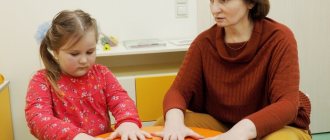Slurred speech or erased dysarthria? Speech therapist advice
It happens that parents and teachers scold the child for inattention, reduce grades for missing letters and for vague answers in class. But the problem is not laziness or inattention, but functional disorders of the nervous system. Doctor of Pedagogical Sciences, professor, speech therapist Elena Arkhipova spoke about erased dysarthria - unintelligibility of speech caused by organic reasons - on the online platform of the Institute of Additional Vocational Education for Social Workers.
Dysarthria is not a purely childhood problem; speech impairment can also occur in adults. And in this case, the help of a speech therapist is also necessary. Let's figure out what dysarthria is, what its causes are and how to work with it.
The exact definition will sound like this: dysarthria is a violation of sound pronunciation and prosody due to a violation of the innervation of the muscles of the speech apparatus. And two more unfamiliar words at once! We'll figure it out further
Prosody is the intonation expressiveness of speech. It is expressed in the rate of speech, voice modulations, intonation, logical stress, etc.
Innervation is a neurological term meaning the conduction of nerve impulses from the brain to the muscles.
It turns out that dysarthria has organic causes, that is, it is associated with disorders in the development of the nervous system. This means that work with her must begin not at the speech therapy level, but at the neurological level. Actually, dysarthria is only a symptom signaling damage to the nervous system.
Causes of dysarthria in children:
- intrauterine pathology;
- birth injuries;
- Rh conflict between child and mother;
- traumatic brain injuries, etc.
Causes of dysarthria in adults:
- cerebrovascular accident;
- traumatic brain injury;
- brain tumors.
Where does work with disarty begin?
The first stage is medical. It is performed by a neurologist. In the arsenal of doctors - the necessary medications, physiotherapy, therapeutic massage, reflexology, in short, means aimed at strengthening the central nervous system and eliminating pathological symptoms.
The second stage is psychological and pedagogical. A whole team of specialists participates in it: educators, defectologists, psychologists, speech therapists. It is important to involve parents too. The goal of this stage is the development of sensory functions, spatial representations, gross motor skills, and fine motor skills.
The third stage is the actual speech therapy stage. A speech therapist eliminates dysarthria in individual sessions.
Erased dysarthria is the most common disorder in preschoolers and primary schoolchildren. Unfortunately, the diagnosis is not always made. Parents and teachers scold the child for inattention, lower grades for missing letters and for unclear answers in class. But it often turns out that the student diligently completes homework, learns the rules and does not make grammatical errors, but misses letters in writing and speaks in monosyllables. His problem is not laziness or inattention, but functional disorders of the central nervous system. And he cannot cope with this with a simple effort of will.
Before starting work with such a child, the speech therapist needs to carefully understand the causes of the problem, and only then choose correction methods.
Tests to identify erased dysarthria.
- For static coordination of movements. Ask your child to stand on one leg for a few seconds. Then to another.
- For dynamic coordination of movements. You need to hit the target with a small ball. For example, into another ball.
- Another dynamic task: jump over a stretched elastic band.
- To study the speed of movements. The child should, at your command, sit on the floor and stand up without using his hands.
- For motor memory. Repeat the series of simple movements shown by you in exactly the sequence and at the speed that you specified.
- For simultaneity of movements. Wind the thread onto the spool while walking in place.
Research shows that children with erased dysarthria have deviations from the standards for all these indicators.
Please note that these tests are not aimed at diagnosing speech development, but at motor skills. The fact is that the development of psychomotor skills is significantly ahead of the development of speech and thinking. Motor development is the basis for the formation of higher mental functions. That is why correctional work with dysarthria begins with the formation of motor skills - general, manual, finger, facial. There is a whole range of exercises to help specialists: finger games, a “magic bag”, performing familiar everyday activities with eyes closed, origami, appliqué, adaptive physical education and much more. The main thing is to remember: the sooner you identify and start working with erased dysarthria, the fewer difficulties the child will have at school, and then in adult life. After all, illegible speech greatly complicates communication, and sometimes even interferes with the choice of profession.
Watch even more webinars from the Institute of Additional Vocational Education on the “I’m at home” portal in the “Online workshops” section
Press service of the Department of Labor and Social Protection of the Population of Moscow
Features of a child with erased dysarthria
Erased dysarthria occurs very often in speech therapy practice. The main complaints with erased dysarthria: slurred, inexpressive speech, poor diction, distortion and replacement of sounds in words with complex syllable structure, etc.
Erased dysarthria is a speech pathology that manifests itself in disorders of the phonetic and prosodic components of the speech functional system and arises as a result of unexpressed microorganic damage to the brain (L.V. Lopatina).
A survey of children in mass kindergartens showed that in senior and preparatory school groups from 40 to 60% of children have deviations in speech development. Among the most common disorders: dyslalia , rhinophonia, phonetic-phonemic underdevelopment, erased dysarthria .
In groups for children with general speech underdevelopment, up to 50% of children, and in groups with phonetic-phonemic underdevelopment, up to 35% of children have erased dysarthria. Children with severe dysarthria need long-term, systematic individual speech therapy assistance. Speech therapists of specialized groups plan speech therapy work as follows: in frontal, subgroup classes with all children they study program material aimed at eliminating general speech underdevelopment, and in individual classes they correct the pronunciation side of speech and prosody, i.e. elimination of symptoms of erased dysarthria.
The erased form of dysarthria is most often diagnosed after five years. All children whose symptoms correspond to erased dysarthria are sent for consultation to a neurologist to clarify or confirm the diagnosis and to prescribe adequate treatment, because in case of erased dysarthria, the method of correctional work should be comprehensive and include: - medical intervention; — psychological and pedagogical assistance; - speech therapy work.
For early detection of erased dysarthria and proper organization of complex effects, it is necessary to know the symptoms that characterize these disorders. The examination of the child begins with a conversation with the mother and study of the child’s outpatient development chart. Analysis of anamnestic information shows that there are: deviations in intrauterine development (toxicosis, hypertension, nephropathy, etc.); asphyxia of newborns; rapid or prolonged labor. According to the mother, “the child did not cry right away; the child was brought in to be fed later than everyone else.” In the first year of life, many were observed by a neurologist and prescribed medication and massage. The diagnosis for up to a year was “PEP” (perinatal encephalopathy). The development of a child after one year, as a rule, is successful for everyone, the neurologist no longer observes these children, and the child is considered healthy. When examined in a clinic by a speech therapist, children aged 5-6 years with erased dysarthria reveal the following symptoms:
GENERAL MOTOR SKILLS. Children with erased dysarthria are motorically awkward, the range of active movements is limited, and the muscles quickly tire during functional loads. They stand unsteadily on one leg, cannot jump on one leg, walk along a “bridge,” etc. They imitate movements poorly: how a soldier walks, how a bird flies, how bread is cut, etc. Motor incompetence is especially noticeable in physical education and music classes, where children lag behind in tempo, rhythm of movements, as well as in switching movements.
FINE MOTOR SKILLS OF HAND. Children with erased dysarthria late and have difficulty mastering self-care skills: they cannot button a button, untie a scarf, etc. During drawing classes, they don’t hold a pencil well and their hands are tense. Many people don't like to draw. Motor clumsiness of the hands is especially noticeable during applique classes and with plasticine. In works on appliqué, difficulties in the spatial arrangement of elements can also be traced. Violation of fine differentiated movements of the hands is manifested when performing sample tests of finger gymnastics. Children find it difficult or simply cannot perform an imitation movement without outside help, for example, “lock” - put their hands together, intertwining their fingers; “rings” - alternately connect the index, middle, ring and little fingers with the thumb, and other finger gymnastics exercises.
During origami classes they experience great difficulties and cannot perform the simplest movements, because... both spatial orientation and subtle differentiated hand movements are required. According to mothers, many children under 5-6 years old are not interested in playing with construction sets, do not know how to play with small toys, and do not assemble puzzles.
School-age children in the first grade experience difficulties in mastering graphic skills (some experience “mirror writing”; substitution of letters “d” - “b”, vowels, word endings; poor handwriting; slow pace of writing, etc.).
FEATURES OF THE ARTICULATING APPARATUS. In children with erased dysarthria, pathological features in the articulatory apparatus are revealed. Pareticity of the muscles of the organs of articulation is manifested in the following: the face is hypomimic, the facial muscles are flaccid upon palpation; Many children do not maintain the closed mouth pose, because the lower jaw is not fixed in an elevated state due to laxity of the masticatory muscles; lips are flaccid, their corners are drooping; During speech, the lips remain flaccid and the necessary labialization of sounds is not produced, which worsens the prosodic aspect of speech. The tongue with paretic symptoms is thin, located at the bottom of the mouth, flaccid, the tip of the tongue is inactive. With functional loads (articulation exercises), muscle weakness increases. Spasticity of the muscles of the organs of articulation is manifested in the following: the face is amicable, the facial muscles are hard and tense on palpation. The lips of such a child are constantly in a half-smile: the upper lip is pressed against the gums. During speech, the lips do not take part in the articulation of sounds. Many children who have similar symptoms do not know how to perform the “tube” articulation exercise, i.e. pull the lips forward, etc. With a spastic symptom, the tongue is often changed in shape: thick, without a pronounced tip, inactive.
Hyperkinesis with erased dysarthria manifests itself in the form of trembling, tremor of the tongue and vocal cords. Tremor of the tongue appears during functional tests and loads. For example, when asked to support a wide tongue on the lower lip with a count of 5-10, the tongue cannot maintain a state of rest, trembling and slight cyanosis appear (i.e., blue tip of the tongue), and in some cases the tongue is extremely restless (waves roll through the tongue in longitudinal or transverse direction). In this case, the child cannot keep his tongue out of the mouth. Hyperkinesis of the tongue is often combined with increased muscle tone of the articulatory apparatus.
Apraxia with erased dysarthria is simultaneously detected in the inability to perform any voluntary movements with the hands and organs of articulation. In the articulatory apparatus, apraxia manifests itself in the inability to perform certain movements or when switching from one movement to another. Kinetic apraxia can be observed when the child cannot smoothly transition from one movement to another. Other children experience kinesthetic apraxia, when the child makes chaotic movements, “groping” for the desired articulatory position. Deviation, i.e. deviation of the tongue from the midline, also manifests itself during articulation tests and during functional loads. Deviation of the tongue is combined with asymmetry of the lips when smiling with a smoothness of the nasolabial fold.
Hypersalivation (increased salivation) is detected only during speech. Children cannot cope with salivation, do not swallow saliva, and the pronunciation side of speech and prosody suffer.
When examining the motor function of the articulatory apparatus in children with erased dysarthria, the ability to perform all articulation tests is noted, i.e. Children, according to instructions, perform all articulatory movements - for example, puff out their cheeks, click their tongue, smile, stretch out their lips, etc. When analyzing the quality of performing these movements, one can note: blurriness, unclear articulation, weakness of muscle tension, arrhythmia, decreased range of movements, short duration of holding a certain pose, decreased range of movements, rapid muscle fatigue, etc. Thus, under functional loads, the quality of articulatory movements sharply falls. During speech, this leads to distortion of sounds, their mixing and deterioration in the overall prosodic aspect of speech.
SOUND PRONUNCIATION. When first meeting a child, his sound pronunciation is assessed as complex dyslalia or simple dyslalia. When examining sound pronunciation, the following are revealed: confusion, distortion of sounds, replacement and absence of sounds, i.e. the same options as for dyslalia. But, unlike dyslalia, speech with erased dysarthria also has disturbances on the prosodic side. Impaired pronunciation and prosody affect speech intelligibility, intelligibility, and expressiveness. Some children go to the clinic after classes with a speech therapist. Parents ask why the sounds that the speech therapist provided are not used in the child’s speech. The examination reveals that many children who distort, omit, mix or replace sounds can pronounce these same sounds correctly in isolation. Thus, sounds in erased dysarthria are produced in the same ways as in dyslalia, but for a long time they are not automated and are not introduced into speech. The most common violation is a defect in the pronunciation of whistling and hissing sounds. Children with erased dysarthria distort and mix not only articulatory complex sounds that are close in place and method of formation, but also acoustically opposed ones. Quite often, interdental pronunciation and lateral overtones are noted. Children have difficulty pronouncing words with a complex syllabic structure; they simplify the sound content by omitting some sounds when consonants are combined.
PROSODICA. The intonation-expressive coloring of the speech of children with erased dysarthria is sharply reduced. The voice, vocal modulations in pitch and strength suffer, speech exhalation is weakened. The timbre of speech is disrupted and sometimes a nasal tone appears. The pace of speech is often accelerated. When reciting a poem, the child’s speech is monotonous, gradually becomes less intelligible, and the voice fades away. The children's voice during speech is quiet, modulation in pitch and voice strength is not possible (the child cannot change the pitch of the voice by imitation, imitating the voices of animals: cows, dogs, etc.). In some children, speech exhalation is shortened, and they speak while inhaling. In this case, speech becomes choked. Quite often, children are identified (with good self-control) in whom, during a speech examination, deviations in sound pronunciation do not appear, because They pronounce the words in a chant, i.e. by syllables, and only violation of prosody comes first.
GENERAL SPEECH DEVELOPMENT. Children with erased dysarthria can be divided into three groups. First group. Children who have impaired sound pronunciation and prosody. This group is very similar to children with dyslalia. Often, speech therapists treat them as dyslastic, and only in the process of speech therapy work, when there is no positive dynamics in the automation of sounds, does a suspicion arise that this is erased dysarthria. Most often, this is confirmed during an in-depth examination and after consultation with a neurologist. These children have a good level of speech development, but many of them have difficulty learning, distinguishing and reproducing prepositions. Children confuse complex prepositions and have problems distinguishing and using prefixed verbs. At the same time, they speak coherent speech and have a rich vocabulary, but may have difficulty pronouncing words with a complex syllabic structure (for example, frying pan, tablecloth, button, snowman, etc.). In addition, many children experience difficulties with spatial orientation (body diagram, concepts of “below-above,” etc.).
Second group. These are children in whom a violation of sound pronunciation and the prosodic side of speech is combined with the incomplete process of forming phonemic hearing. In this case, children encounter isolated lexical and grammatical errors in their speech. Children make mistakes in special tasks when listening and repeating syllables and words with oppositional sounds - for example, when asked to show the desired picture (mouse-bear, fishing rod-duck, scythe-goat, etc.).
Thus, in children, the auditory and pronunciation differentiation of sounds is unformed. Children's vocabulary lags behind the age norm. Many people experience difficulties in word formation, make mistakes in agreeing a noun with a numeral, etc. Sound pronunciation defects are persistent and are regarded as complex, polymorphic disorders. This group of children with phonetic-phonemic underdevelopment (FFN) and erased dysarthria should be referred by the speech therapist of the clinic to the MPC (medical-pedagogical commission), to a specialized kindergarten (to the FFN group).
Third group. These are children who have a persistent polymorphic disorder of sound pronunciation and a lack of prosodic aspect of speech combined with underdevelopment of phonemic hearing. As a result, the examination reveals a poor vocabulary, pronounced errors in grammatical structure, the impossibility of a coherent statement, and significant difficulties in mastering words of different syllabic structures.
All children in this group demonstrate undeveloped auditory and pronunciation differentiation. Ignoring prepositions in speech is indicative. These children with erased dysarthria and general speech underdevelopment (GSD) should be sent to MPC (in specialized kindergarten groups) to GSD groups. Thus, children with erased dysarthria are a heterogeneous group. Depending on the level of development of linguistic means, children are sent to specialized groups: - with phonetic disorders; - with phonetic-phonemic underdevelopment; - with general speech underdevelopment .
(according to E. F. Arkhipova)
Do you need a speech therapist in Sviblovo? Sign up for a consultation by phone or through the feedback form in the “Contacts” section.






